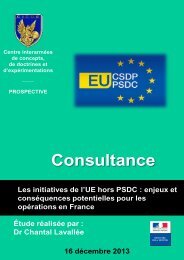Conference
science-research-bulletin-2013-conference
science-research-bulletin-2013-conference
You also want an ePaper? Increase the reach of your titles
YUMPU automatically turns print PDFs into web optimized ePapers that Google loves.
EUROPEAN POLICE SCIENCE AND RESEARCH BULLETIN<br />
SPECIAL CONFERENCE EDITION<br />
a number of commentators have observed<br />
the considerable and simultaneous losses<br />
experienced in the movement to integration. In<br />
a review of career advancement during this time,<br />
Brown (2008) argues that women officers fared<br />
worse in achieving promotion when compared to<br />
men. She suggests that this was because women<br />
were now competing against the total number<br />
of eligible officers instead of being considered in<br />
terms of the number of appropriately qualified<br />
women from the previously separate Police<br />
Women’s Department. Women who had reached<br />
senior positions in the separate policewomen’s<br />
service were forced to relinquish them as they<br />
joined forces with men. Such findings are<br />
echoed in the work of Schulz (1995) and Miller<br />
(1999) who record the double-edged impact<br />
that integration and the move to patrol in the<br />
late 1960s was to bring to policewomen in the<br />
US. In securing the transition into mainstream<br />
policing, many policewomen were to turn their<br />
back on their traditional roles. Schulz (1995, p.1)<br />
notes that in the movement toward equality,<br />
policewomen were ‘forced to reject their<br />
history…[and] repudiate their past’. Brown and<br />
Heidensohn (2000, p.4) concur describing the<br />
move towards integration as ‘… the striking of<br />
a somewhat Faustian bargain’ with the price of<br />
admittance resulting in a loss of a radical agenda<br />
and the acceptance of male definitions and<br />
methods of control.<br />
But that was then, this is now. We now exist in<br />
a post-rights democratic culture in which the<br />
main tenets of equality have been enshrined<br />
and embedded into macro and micro structures,<br />
into organisational and everyday discourse — a<br />
discourse that suggests that the major battles<br />
encountered by women have been fought and<br />
won. We are now living in a reality identified as<br />
‘the post-feminist era’, a space in which girls who<br />
have benefited from an equalities policy discourse<br />
are ‘mobilised as the embodiment of the values of<br />
a new meritocracy’ (McRobbie, 2012, p58). It is<br />
here that the young woman more particularly has<br />
been released from any constraints. Constructed<br />
as the ‘can do’ girl, if she just works hard and long<br />
enough, she can do it, anything is possible….<br />
she is a privileged subject, independent, selfreliant<br />
and ‘empowered’ (Harris, 2004 cited in<br />
McRobbie, 2012, pp. 58-60). This is a world in<br />
which ‘all things are equal now’ and a world in<br />
which there is no more need for an ideology such<br />
as feminism. Twenty first century girls and women<br />
no longer work within a framework of feminism<br />
but through a framework of modernisation — the<br />
project of ‘Gender Mainstreaming’ — the process<br />
of integrating the aims of gender equality and<br />
women’s rights into the agendas, policies, and<br />
practices of governments and organisations. In<br />
describing gender mainstreaming, McRobbie<br />
(2012, p.152) asserts that it is best thought of as a:<br />
non-conflictual accommodating kind of<br />
programme…. [whose]…vocabulary is modern,<br />
managerial and professional, a programmatic<br />
approach, with all kinds of tools for evaluation and<br />
assessment of outcomes which can be rolled out as<br />
good practice within corporate as well as state and<br />
public sector institutions.<br />
Alongside other public sector organisations, the<br />
police service in England and Wales has done<br />
much over the past decade to mainstream gender<br />
into its activities, through the development of<br />
a series of evaluation tools and good practice<br />
measures. Through such activity, the structural<br />
obstacles that women police so often described<br />
in their history of struggle appear to have been<br />
dismantled and women can be found engaged<br />
in a range of policing tasks and ranks previously<br />
closed to them. Above all else, the transformative<br />
possibilities of recruiting a diverse police<br />
workforce are increasingly being recognised in<br />
England and Wales and beyond as an opportunity<br />
to substantially reform and reconfigure policing<br />
for the better, bringing about improvements to<br />
both internal dynamics within policing and to<br />
external interactions with communities (Silvestri<br />
et al, 2013).<br />
WOMEN POLICE:<br />
A TRANSFORMATIVE<br />
OPPORTUNITY OR<br />
A RESPONSE TO CRISIS?<br />
A recent joint report published by ACPO, APA and<br />
the Home Office, Equality, Diversity and Human<br />
Rights Strategy for the Police Service (2010) outlines<br />
a number of benefits in relation to the recruitment<br />
of a more diverse police workforce. These include<br />
the potential to achieve: a broader range of<br />
information for decision-making and a wider range<br />
of possible solutions; a willingness to challenge<br />
established ways of thinking and consider new<br />
options; improvements in the overall quality of<br />
the team; better staff management, leading to<br />
improvements in staff satisfaction; a reduction<br />
in the number of employees leaving the service,<br />
145





